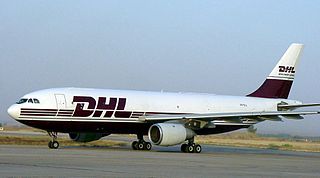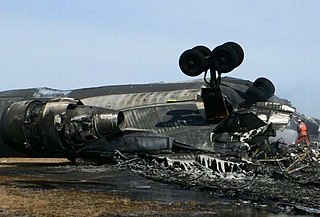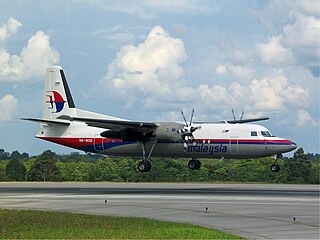
The Kegworth air disaster occurred when British Midland Airways Flight 092, a Boeing 737-400, crashed onto the motorway embankment between the M1 motorway and A453 road near Kegworth, Leicestershire, England, while attempting to make an emergency landing at East Midlands Airport on 8 January 1989.

Delta Air Lines Flight 1141 was a scheduled domestic passenger flight between Dallas/Fort Worth, Texas and Salt Lake City, Utah. On August 31, 1988, the flight, using a Boeing 727-200 series aircraft, crashed during takeoff, resulting in 14 deaths and 76 injuries of the 108 on board.

On August 16, 1987 a McDonnell Douglas MD-82, operating as Northwest Airlines Flight 255, crashed shortly after takeoff from Detroit Metropolitan Airport, about 8:46 pm EDT, resulting in the deaths of all six crew members and 148 of the 149 passengers, along with two people on the ground. The sole survivor was a 4-year-old girl who sustained serious injuries. It was the second-deadliest aviation accident at the time in the United States. It is also the deadliest aviation accident to have a sole survivor.

A compressor stall is a local disruption of the airflow in the compressor of a gas turbine or turbocharger. A stall that results in the complete disruption of the airflow through the compressor is referred to as a compressor surge. The severity of the phenomenon ranges from a momentary power drop barely registered by the engine instruments to a complete loss of compression in case of a surge, requiring adjustments in the fuel flow to recover normal operation.

American Airlines Flight 157, a Douglas DC-6, departed on November 29, 1949, from New York City bound for Mexico City with 46 passengers and crew. After one engine failed in mid-flight, a series of critical mistakes by the flight crew caused the pilot to lose control of the plane during the final approach to a routine stopover at Love Field in Dallas, Texas. The airliner slid off the runway and struck a parked airplane, a hangar, and a flight school before crashing into a business across from the airport. 26 passengers and two flight attendants died. The pilot, co-pilot, flight engineer, and 15 passengers survived.

On 22 November 2003, shortly after takeoff from Baghdad, Iraq, an Airbus A300B2-200F cargo plane, registered OO-DLL and owned by the Belgian division of European Air Transport, was struck on the left wing by a surface-to-air missile while on a scheduled flight to Muharraq, Bahrain. Severe wing damage resulted in a fire and complete loss of hydraulic flight control systems. Because outboard left wing fuel tank 1A was full at takeoff, no fuel-air vapour explosion occurred. Liquid jet fuel dropped away as 1A disintegrated. Inboard fuel tank 1 was pierced and leaking.

S7 Airlines Flight 778(S7778/SBI778) was a scheduled domestic passenger flight from Moscow to Irkutsk, Russia. On 9 July 2006, at 06:44 local time, the Airbus A310-324 aircraft operating the route overran the runway during its landing in Irkutsk. The aircraft failed to stop and crashed through the airport's concrete perimeter fence, struck rows of private garages and burst into flames, killing 125 people.

Trans World Airlines (TWA) Flight 159 was a regularly scheduled passenger flight from New York City to Los Angeles, California, with a stopover in Cincinnati/Northern Kentucky International Airport, Kentucky, that crashed after an aborted takeoff from Cincinnati on November 6, 1967. The Boeing 707 attempted to abort takeoff when the copilot became concerned that the aircraft had collided with a disabled DC-9 on the runway. The aircraft overran the runway, struck an embankment and caught fire. One passenger died as a result of the accident.

Czechoslovak Airlines Flight 001 was an Ilyushin Il-18B four engine turboprop airliner, registered OK-NAB, which was operating as a scheduled domestic passenger flight from Prague's Ruzyně airport to Bratislava-Ivanka Airport, both in Czechoslovakia, which crashed into the Zlaté Piesky Lake while attempting to land in Bratislava on July 28, 1976. All 6 crew members and 70 out of 73 passengers died.

Pan Am Flight 6 was a round-the-world airline flight that ditched in the Pacific Ocean on October 16, 1956, after two of its four engines failed. Flight 6 left Philadelphia on October 12 as a DC-6B and flew eastward to Europe and Asia on a multi-stop trip. On the evening of October 15 the flight left Honolulu on a Boeing 377 Stratocruiser Clipper named Sovereign Of The Skies. The accident was the basis for the 1958 film Crash Landing.

One-Two-Go Airlines Flight 269 (OG269) was a scheduled domestic passenger flight from Bangkok to Phuket, Thailand. On 16 September 2007, about 15:41 ICT, the McDonnell Douglas MD-82 operating the flight crashed into an embankment beside runway 27 at Phuket International Airport (HKT) bursting into flames upon impact during an attempted go-around after an aborted landing, killing 90 of the 130 persons on board. It is the third deadliest aviation incident to occur in Thailand.

On 26 May 2008, Moskovia Airlines Flight 9675, a Moskovia Airlines An-12 cargo aircraft crashed near Chelyabinsk, Russia. After taking off for a flight to Perm, it turned back due to a fire on board and crashed 11 kilometres from the airport, killing all nine crew members.

On 11 February 1978, Pacific Western Airlines Flight 314, a Boeing 737-200, crashed at Cranbrook/Canadian Rockies International Airport, near Cranbrook, British Columbia, Canada, killing 43 of the 49 people on board.

FedEx Express Flight 80 was a scheduled cargo flight from Guangzhou Baiyun International Airport in the People's Republic of China, to Narita International Airport in Narita, Chiba Prefecture, Japan. On March 23, 2009, the McDonnell Douglas MD-11F (N526FE) operating the flight crashed at 6:48 am JST, while attempting a landing on Runway 34L in gusty wind conditions. The aircraft became destabilized at flare and touchdown resulting in an unrecovered "bounced" landing with structural failure of the landing gear and airframe, and came to rest off the runway, inverted, and burning fiercely. The captain and first officer, the jet's only occupants, were both killed.

Scottish Airlines (Prestwick) Limited was formed in 1946 as a subsidiary of Scottish Aviation Limited. The airline commenced worldwide passenger and cargo charter flights from bases at Prestwick and Stansted. It also participated in the Berlin Airlift, became a trooping carrier for the British Armed Forces, and began contract flights on behalf of Air France, British European Airways (BEA), Compagnie Belge des Transports Aériens, Iceland Airways and KLM.
Several aviation incidents and accidents have occurred in which the control surfaces of an aircraft became disabled, often due to failure of hydraulic systems or the flight control system. Other incidents have occurred where controls were not functioning correctly prior to take-off, either due to maintenance or pilot error, and controls can become inoperative from extreme weather conditions. Aircraft are not designed to be flown in such circumstances; however, a small number of pilots have had some success in flying and landing aircraft with disabled controls.

Ozark Air Lines Flight 809 was a regularly scheduled flight from Nashville, Tennessee, to St. Louis, Missouri, with four intermediate stops. On July 23, 1973, while landing at St. Louis International Airport, it crashed, killing 38 of the 44 persons aboard. A severe downdraft, associated with a nearby thunderstorm, was cited as the cause.

On December 27, 1968, North Central Airlines Flight 458 crashed into a hangar while attempting a night landing in poor weather at O'Hare International Airport in Chicago, Illinois, in the United States. Of the 41 passengers and four crew members, only 17 passengers and one crew member survived. One person was killed and six were injured on the ground.

Linea Aeropostal Venezolana Flight 253 was a regularly scheduled passenger flight from Idlewild International Airport, New York to Caracas International Airport in Caracas, Venezuela. During the 20 June 1956 operation of the flight, approximately one hour and twenty minutes after departure, the flight crew reported trouble with one of the engines and turned back to New York. While dumping fuel in preparation for landing, the airplane, a Lockheed L-1049 Super Constellation, caught fire and plummeted into the Atlantic Ocean off Asbury Park, New Jersey. All 74 aboard were killed; at the time, it was the world's deadliest disaster involving a scheduled commercial flight. However, its death toll would be surpassed only ten days later.

Malaysia Airlines Flight 2133 (MH2133/MAS2133) was a scheduled domestic passenger flight from Kota Kinabalu to Tawau, operated by Malaysia's flag carrier Malaysia Airlines. On 15 September 1995, the Fokker 50 carrying 53 people flew into a shanty town after the pilots failed to stop the aircraft while landing in Tawau, killing 32 of the 49 passengers and 2 of the 4 crew on board. This was the first hull loss of a Fokker 50.



















